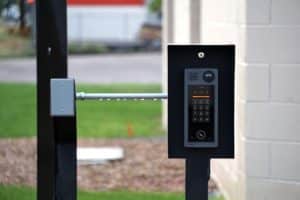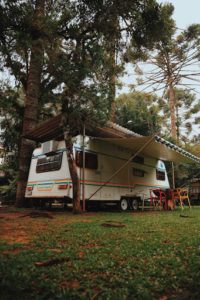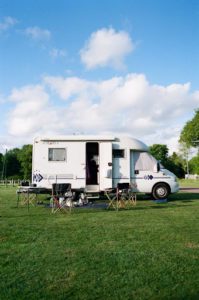Key Tips for Storing Your RV This Summer
You and your recreational vehicle have gone on your fair share of trips this summer! Whether you have been going up and down the coast or hopping from one national park to the another, your RV has covered a lot of ground.
But when work obligations or extreme weather approach, your RV may be put into storage for a break. No matter how long the period of storage is, you’ll need to know how to properly store your RV.
This is where we can help! We are here to provide some tips and tricks to help you find the right storage facility to protect your recreational vehicle.
Finding the Right Storage Facility
When searching for a suitable RV storage facility, there are a few important things to consider. First, you will want to find a storage space that is relatively close to your home. This will make things such as maintenance chores and unpacking more convenient.
Second, finding a storage place with the proper security measures is essential. This will ensure your travel trailer is protected from any destruction or damage from other personnel. Additional things you will want to look for are storage yards with high-quality security cameras, high perimeter fencing, as well as gate access via personal codes.

The pricing of every RV storage facility varies based on the following factors such as location, size of the rental site, and the type of storage. For instance, an indoor storage facility is relatively more expensive than an outdoor storage facility. An indoor storage facility may be worth the investments as you consider your region’s climate conditions. If money is not an issue then you may want to consider an indoor climate-controlled facility. This can ultimately be more expensive, but it will provide the best storing conditions for your recreational vehicle to ensure the interior and exterior do not receive any damage.
Benefits of Covered RV Storage Facilities

Covered RV storage can be an essential investment for RV owners. Storing your RV in a covered self-storage facility can prolong its life and make sure no further maintenance damages occur by rain, sun, wind, or upcomin snow. This is very beneficial because it can reduce maintenance fees annually. If you plan on putting your RV in long-term storage, a covered facility will ideally be best suited for you economically. A covered storage facility will provide year-round protection from everything from UV rays to blizzards.
4 Tricks for Preserving your RV In the Summer Heat
Protecting your recreational vehicle from extreme heat measures means focusing many efforts on the exterior. You will want to consider specific tactics for treating the exterior as well as finding products that can protect your RV from UV rays. Below we have provided a handy guide for preserving your RV in summer storage.
1. Exterior Maintenance and Covering
Before you store your RV you must first give it a thorough cleaning. The importance of cleaning and waxing the exterior is to prevent any abrasive dirt or sand from eroding the surface. This will ensure there is no occurrence of any external openings. Waxing the surface will also help protect your RV from any sun damage by sealing the surface.

If your RV is placed in a storage facility that does not have covered parking spaces, then an RV cover is essential. There are multiple different covers on the market; however, one kind is superior to all others. Purchasing a cover that is made of high-quality, breathable material such as polypropylene or polyester that has open vents will provide the best protection.
RV covers are essential whether you are using an indoor or outdoor storage facility. They provide a variety of benefits such as protection for the plumbing system, waste tanks, and air intake piping. A breathable cover will also prohibit the growth of mold or mildew in the areas above by allowing all trapped moisture to evaporate.
2. Window Covers And Moisture Protection
Your RV dashboard and windows are exposed to UV rays daily whether you’re on a road trip or storing your RV. This often can result in faded windows or a cracked dashboard, which RV insurance does not cover. As such, windshield covers are very important. We also suggest closing all nighttime shades in your RV, as it can only decrease the chances of sunlight entering your RV. This helps to prevent the cracking of wood or plastic finishes and the fading of upholstery, couches, beds, carpet, and flooring materials.

You will need to increase or decrease the humidity in your RV depending on the climate you live in. Doing so properly can help prevent insects, rodents, and mildew.
Increasing Humidity
If your RV is stored in a very dry climate you will want to focus on increasing the humidity. Many RV owners will place a 5-gallon bucket in the center RV. This will put enough moisture in the air to prevent the wood from drying or cracking. Be sure to open all cabinets and closet doors to let the humidity be evenly distributed among the RV.
Decreasing Humidity
On the other hand, if your RV is placed in a moist and warm climate you will want to use DampRid or place buckets of silica gel packets throughout the RV to absorb the moisture from the air. This will help prevent the build-up of mold and mildew while increasing overall airflow.
3. Insect and Rodent Protection
To keep your RV in tip-top shape it’s important to prevent any insects and rodents from entering. Once a few are inside they breed rapidly and you could come back to an infestation the following season.

First and foremost, you will want to clean the RV thoroughly and remove all food and water resources. Even the smallest crumbs can attract insects and rodents, especially mice. Cleaning the exterior fridge panel as well as underbelly access points will prevent any bugs from hatching their eggs. Infestation of insects or rodents will require a pest control professional, which could be very costly.
Once the interior of the vehicle is clean you will want to inspect your RV thoroughly. Be sure to check underneath the RV for any areas that could allow pests to enter. Check rooftop and plumbing vents and be sure to seal any cracks or open areas with spray foam.
4. Mechanical Considerations When Storing RV
Make sure you completely power down your vehicle to prevent the deterioration of electronic and mechanical parts. This will also prevent you from worrying about a dead battery or malfunctioning parts when you take your RV out the next time.

If you are keeping your RV in storage for more than a month, you will need to fill the fuel tank and add a fuel stabilizer. Keep in mind that once the stabilizer is in place, it’s essential to run the engine and generator to ensure the stabilizer spreads through the entire fuel system. The fuel stabilizer will keep the engine in tip-top shape and prevent further problems from occurring with any power sources and mechanical parts underneath the vehicle.
How to Get Ready For Next Summer Adventure

We all know the RV life can be very overwhelming, especially when it comes to preserving your vehicle and finding the right RV storage facility. Cleaning and maintaining the exterior and interior of your RV can be very difficult, especially after years of use. At McDowell’s, we specialize in upholstery services so you can enjoy being on the road embarking on your next adventure.
If your recreational vehicle has had any interior damage from your summer adventures, schedule an appointment with McDowell’s. We work for all the major RV dealers here in the valley, meaning there is no job too big for us here at McDowell’s.

